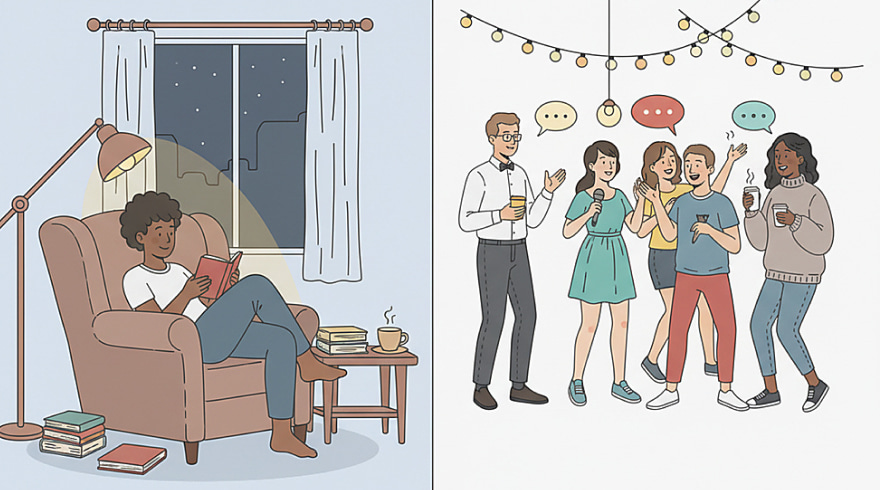Understanding Introversion and Extraversion: A Practical, Science-Informed Guide
- 15 October 2025

What These Traits Really Mean
Introversion and extraversion are enduring patterns of how people manage energy, attention, and stimulation. Rather than labels that box someone in, they describe preferred conditions for thriving. An introverted person often renews by reducing external input and deepening focus, while an extroverted person frequently renews by increasing interaction and novelty. Both orientations can enjoy solitude and social time; the distinction lies in which context restores vitality most reliably. Think of a personal thermostat for stimulation: some feel best when the dial is lower, others when it is higher, and most can adjust temporarily when life demands it. When people talk about the difference between introvert and extrovert, they’re really describing where attention and energy most naturally flow. The introverted orientation tends to favor internal processing, slower ramps into activity, and a preference for fewer, richer interactions. The extroverted orientation typically emphasizes external cues, faster behavioral tempo, and a broader social bandwidth. Crucially, neither path limits capability; these are tendencies, not ceilings. With practice and healthy boundaries, anyone can flex outside their comfort zone and still protect their core energy patterns.
Personality scientists frame these patterns along a continuum rather than a binary. You might land near the middle and feel context-sensitive, sometimes called ambiverted, or “flexi-vert.” Biological and environmental factors both matter: baseline arousal regulation, reward sensitivity, cultural norms, and learned strategies all shape how these traits show up. Over the lifespan, roles, routines, and responsibilities can shift the visible expression without uprooting your underlying preference.
How Differences Show Up in Daily Life
Daily rhythms highlight these orientations in subtle ways. One person might begin mornings with reflective journaling before engaging, another might seek a lively conversation to kick-start momentum. The former may guard calendar white space to prevent cognitive overload; the latter may stack collaborative sessions that generate creative momentum. Neither approach is inherently superior; the better approach is situational fit. In teams, matching task demands to energy patterns deep-focus analysis to those who enjoy sustained concentration, rapid idea-storming to those who enjoy spontaneous exchange reduces friction and accelerates outcomes.
In workplace settings, the difference between extrovert and introvert often emerges through preferred meeting formats and pacing. Brainwriting or asynchronous feedback can help quieter voices contribute fully, while stand-ups and live brainstorming can galvanize those who think aloud. Beyond meetings, recovery rituals matter: an introverted engineer might recharge by walking solo after code reviews, whereas an extroverted salesperson might gain energy by chatting with colleagues between calls. Across domains like learning, leadership, and creativity, the smartest systems let people regulate input intensity and choose methods that match their attentional sweet spot.
At-a-Glance Comparison
Use this quick reference to translate abstract traits into concrete, everyday choices that support performance and well-being.
| Domain | Introversion Signals | Extraversion Signals |
|---|---|---|
| Energy Recovery | Solitude, quiet hobbies, depth over breadth | Social interaction, variety, movement |
| Communication | Think-then-speak, concise contributions | Speak-to-think, dynamic dialogue |
| Focus Style | Long stretches, fewer switches | Short bursts, frequent switching |
| Motivation | Inner standards, personal meaning | External momentum, visible progress |
| Social Bandwidth | Smaller circles, deeper ties | Larger networks, broader reach |
Treat these rows as tendencies, not rules. People flex under deadlines, adapt with practice, and combine elements based on role demands. You can adopt the column you need for the moment, then return to your natural base for recovery. That rhythm flex and restore is the heart of sustainable performance.
Myths and Misreadings to Leave Behind
Misconceptions persist because surface behaviors are easy to misread. A quiet person in a meeting isn’t necessarily disengaged; they may be synthesizing. A chatty teammate isn’t automatically unfocused; they may be prototyping ideas aloud. The key is intent and fit. When behavior aligns with purpose and context, it becomes an asset. When it clashes with the environment, it can look like friction. Instead of forcing identical styles, organizations can define outcomes and let people choose routes that suit their bandwidth and tempo.
Common myths deserve a clear rebuttal: introversion is not shyness, and extraversion is not recklessness. Shyness involves fear; introversion involves preference. Recklessness involves poor risk evaluation; extraversion involves higher comfort with social stimulation. Another myth claims leaders must be outspoken to inspire. Evidence shows reflective leaders often excel in calm analysis, while outgoing leaders mobilize in high-ambiguity environments. The best leadership adapts: listen deeply in discovery, speak decisively in execution, and know when to switch gears. Nuance beats stereotypes, especially when stakes are high and teams are diverse.
- Preference does not equal skill; training widens capability regardless of orientation.
- Silence can be a strategic pause, not a void to fill.
- Talkativeness can be structured into productive iteration.
- Context determines which style advances the goal in front of you.
Strengths and Benefits Across Work, Learning, and Life
Each orientation brings assets that become powerful when deliberately cultivated. Introverted strengths often include deep listening, meticulous preparation, and pattern detection over long timescales. These traits shine in complex analysis, risk assessment, and craftsmanship that rewards precision. Extroverted strengths frequently include rapid rapport, visible enthusiasm, and real-time improvisation. These traits excel in coalition building, stakeholder alignment, and momentum-making during change. When combined on a team, you get exploration and exploitation, divergence and convergence a full innovation cycle.
Under pressure, the phrase difference introvert extrovert points to contrasting recovery strategies rather than fixed ability. Some people need quiet debriefs, asynchronous notes, and protected focus blocks to bounce back; others restore faster through huddles, quick wins, and celebratory check-ins. Both can deliver elite outcomes if rhythms are respected. For learners, study sprints with solo review may beat marathon groups, while others thrive in cohort discussions. For families, planning social calendars with “buffer days” or “connection bursts” can prevent burnout and resentment, keeping relationships resilient and warm.
- Introverted benefits: depth, steadiness, signal-to-noise sensitivity, and thoughtful risk mitigation.
- Extroverted benefits: outreach, morale lifting, opportunity scanning, and fast-cycle experimentation.
- Shared payoff: mutual appreciation reduces bias, and complementary pairing multiplies results.
Communication, Collaboration, and Conflict Tips
Effective collaboration starts with designing interactions that honor different cognitive tempos. Before meetings, circulate agendas and problem statements; this practice helps reflective thinkers prepare and helps talk-first thinkers warm up with context. During discussions, rotate facilitation to balance airtime, use time-boxed rounds to surface every voice, and capture insights in shared notes. Afterward, allow asynchronous follow-ups, because many high-value ideas emerge once adrenaline subsides. These rituals transform style differences from friction into throughput.
In conflict, separate content from cadence. If one person processes internally and the other processes aloud, set guardrails such as “clarify first, debate second,” or “summarize the other side before defending your own.” Negotiate recovery windows: some need a pause to think; others need closure quickly. Agree on signals “I need five for clarity” or “Let’s capture actions now” so nobody feels stonewalled or steamrolled. Over time, teams that codify these norms see fewer escalations, quicker resolutions, and stronger trust, because predictability lowers social anxiety and preserves cognitive resources for problem-solving.
- Prepare together, contribute differently, decide deliberately, and document decisions.
- Alternate high- and low-stimulation formats to keep everyone in their optimal zone.
- Praise outcomes publicly and share nuanced feedback privately to respect energy needs.
FAQ: Clear Answers About Introversion and Extraversion
Are introversion and extraversion fixed or flexible?
They’re relatively stable preferences with room for situational flex. You can stretch your range with practice, but sustained performance still benefits from restorative habits that suit your baseline.
Can someone be a mix of both?
Yes, many people sit near the midpoint and adapt based on the stakes, the audience, or the environment. In research terms, the difference between introverts and extroverts is a probabilistic pattern, not a hard boundary.
Why do some social events feel energizing one day and draining another?
Sleep quality, task load, context safety, and novelty all influence stimulation tolerance. Even the most gregarious person has limits, and the most reflective person can enjoy lively gatherings when the conditions align.
Which style makes a better leader?
Neither by default. Leadership effectiveness rises when style meets context: stabilizing teams benefit from calm analysis, while turnaround teams benefit from high-visibility momentum. The best leaders purposefully blend both modes.
How can teams support both orientations fairly?
Offer multiple contribution channels, balance synchronous and asynchronous work, and measure outcomes rather than airtime. Build shared rituals clear agendas, time-boxed rounds, written recaps that let every brain work at its best.
Bringing It Together for Real-World Results
Translating personality insight into impact is about ergonomics for the mind. Calibrate your stimulation “desk” lights, noise, schedule, and social cadence the same way you would a physical workstation. Protect deep-focus windows if you thrive on immersion, and architect energizing check-ins if you feed on interaction. Leaders should treat meetings as design problems: match format to objective, then sequence activities to harvest both reflection and spontaneity.
Culture shifts when teams normalize recovery without stigma. Quiet time after high-intensity work is not avoidance; it’s maintenance. Energizing debriefs after solo efforts are not a distraction; they’re integration. Small moves, rotating facilitation, mixing pre-read and live ideation, pacing deadlines compound into fewer dropped balls and more durable motivation. As you refine these rhythms, you’ll see clearer thinking, faster learning cycles, stronger relationships, and a healthier feedback loop between effort and renewal. In the long run, honoring human energy patterns is not just kind; it’s an operational advantage that compounds every quarter.
Latest News
-
![The Complete Guide to Extroverted and Introverted Types]()
- 20 October, 2025
-
![Introvert Vs Extrovert Test: Understanding Your Social Energy Style]()
- 19 October, 2025
-
![The Energizing World of Extroverted Personality Type: Skills and Real-Life Success]()
- 18 October, 2025



